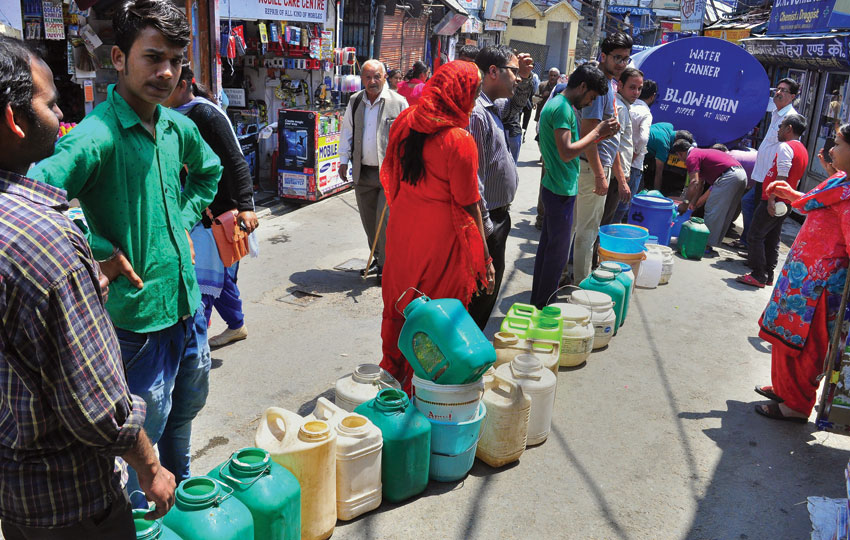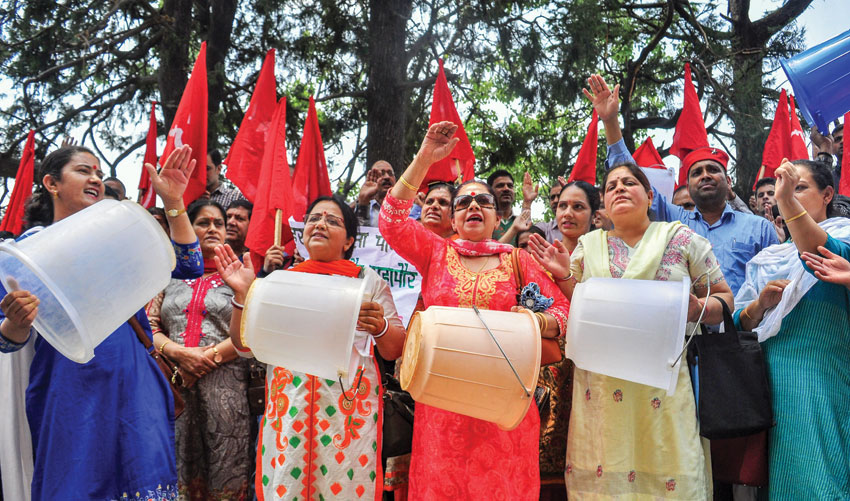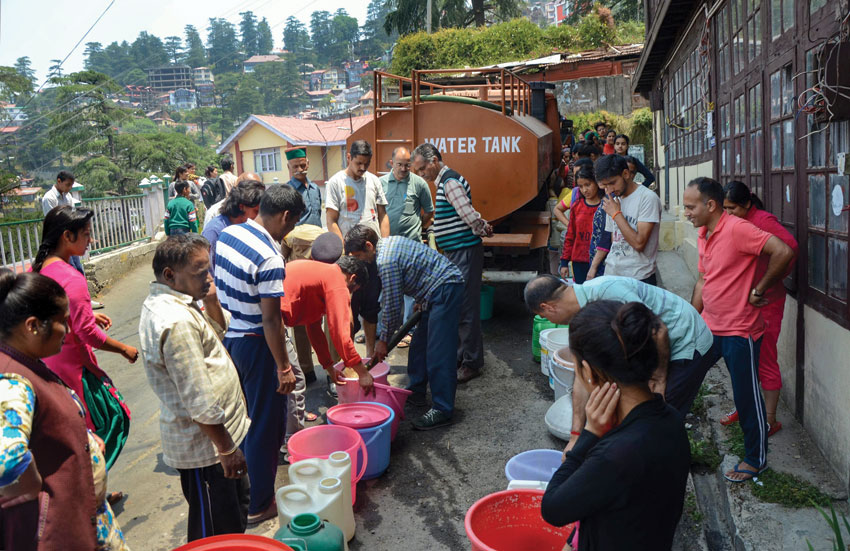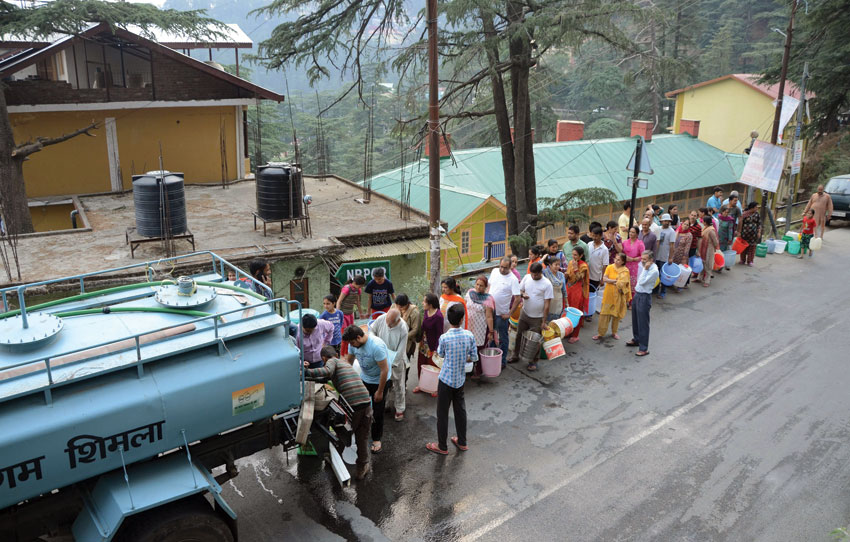As The Water Levels Plummet, India Facing An Existential Water Crisis
People in the northern hill town of Shimla to collect drinking water from a tanker as the city faces acute shortage of drinking water, May 27. (Press Trust of India)
The water crisis in India is touching dangerous levels and yet the country seems oblivious of the needs for conserving water on a war footing. This is despite the fact that India is not a water-scarce country, as it receives an average annual rainfall of 1170 millimeters, writes Priyanka Bhardwaj.
A steadily growing population that is expected to reach the 1.7billion by 2050, a rapidly increasing middle class that is turning towards a protein rich diet that requires more quantities of water to produce, drying up of rivers and water-bodies, depleting groundwater levels and continuance of age old mismanagement of water resources, indifference and incompetence of policymakers and administrators, and poor implementation of advanced technologies, have left the entire land high and dry.
Water deficit is also due to effluents and hazardous materials contaminating water sources within and near to populated zones, resulting in not enough clean water in almost every human habitation or city.
The latest city to be facing the existential water crisis is Simla, the capital of Himachal Pradesh, also known as the “Queen of the Hills” and the summer capital of British India since 1863.
It is a popular “go-to” summer destination for Indian and foreign visitors but this summer city-based hotels and residents are requesting tourists to stay away due to lack of water supply for the tenth day in a row and those who have already arrived, are having to manage with just a bottle of mineral water a day.

Originally designed by the British for 25,000 residents, the city now houses ten times that population size, and to this the burgeoning visitor numbers that shoots up to 90,000 to 100,000 in peak times have only added to the stress on the 22 million liters of water supply available in a day.
With sewerage water mixing in the waters of Ashwani Khud, the only water source of the city, and resultant shutting of this source has made the situation so grim that the police have been roped in to manage distribution of water to prevent water wars.
An old problem, every election season political aspirants make tall promises only to let the situation deteriorate with time.
Moving on to the National Capital, New Delhi, water-matters are worse.
In water-clashes between groups of people, three lives have already been lost and violent agitations have reached the gates of Varunalaya, the Delhi Jal Board (DJB) headquarters at Jhandewalan, near the shopping hub of Karol Bagh.

In mid-May the DJB warned that the city will not be able to survive on only 120 cusecs of water from Yamuna River and approached the Supreme Court, the Delhi High Court and the National Green Tribunal to instruct neighboring Haryana to supply 420 cusecs of potable water daily to Delhi.
Though Haryana relented to supply Delhi with 120 cusecs of water till the advent of monsoons in July, with the rider that Delhi drops all cases against the state, this can be treated only as an interim relief.
A stark neglect of water conservation is evident from the fact that towards the beginning of this century the millennium city of Gurugram, previously called Gurgaon, south of South Delhi was dotted by large and deep ponds that came under the “saamlaat” but rapidly disappeared with the tacit collusion of village and local representatives in collusion with land sharks.
It would require an expert geologist to pin point the exact locations of deep lakes that existed in the DLF Phase III and Nathupur Village that touch the famed Cyber City, Sukhrali and Rajiv Chowk areas that now boast of “heat emitting” world class towers and other infrastructure.
Down in the southern states, matters are not board as we saw the Supreme Court tried hard to settle the more than a century old Cauvery River water dispute between Karnataka and Tamil Nadu.
Recently Bengaluru, the capital of Karnataka and the Silicon Valley of India, made news for its acute water-scarcity and going the Cape Town way.
Here too the story of is of declining water bodies, as more than 1,000 percent increase in concretization is preventing recharge of groundwater, huge multiplying of population that accelerates demand every year, indiscriminate installation of water extraction pumps, and water bodies choked with garbage and waste, driving poor families who earn no more than Rs.200 a day to spend Rs.2-5 on every pot of water.
The above three cities are reflective of a pan India problem as the WorldAid 2016 report categorizes India among the worst countries in the world for the number of people without safe water, 163 million lack access to safe drinking water.
That the nation uses more groundwater than the U.S. and China combined reveals the failure in groundwater regime.
About 230-250 cubic kilometers of groundwater are used annually and this accounts for about a quarter of the global groundwater use.

As far as rivers that are the lifeline are concerned, interstate and inter-nation conflicts have become the order of the day.
Rivers Ganga, Yamuna and Saraswati are flowing the dirtiest with a deadly mix of pollutants both hazardous and organic on sporadic, seasonal rains do not always arrive in the places they are required the most.
The results are drought and floods that lead to crop failures and farmer suicides and the impact on urban well off is in terms of immense challenges while devastating for the poor.
NASA reports of 2009 reveal that the Indus basin that supports Haryana and Punjab, granaries of the country, was the second-most over-stressed aquifer in the world and noted that the rate of depletion of groundwater levels in north India is about a meter every three years.
In coastal aquifers there is the case of seawater intrusion and geogenic pollution of groundwater.
If these trends are not reversed then a quarter of agricultural lands may be affected thus leading to loss of food, agricultural employment, husbandry, industrial growth and human health.
Estimates of the Union Ministry of Water Resources, for water requirements for 2025 and 2050 are 1200 billion cubic meters (bcm) and 1447 bcm respectively as compared with 1100 bcm of today.
Forecasts by the Asian Development Bank for India are that it will face water deficit of 50 percent by 2030.
Only a combined long-term commitment and a strong connection with this idea can save water and life that it sustains.


